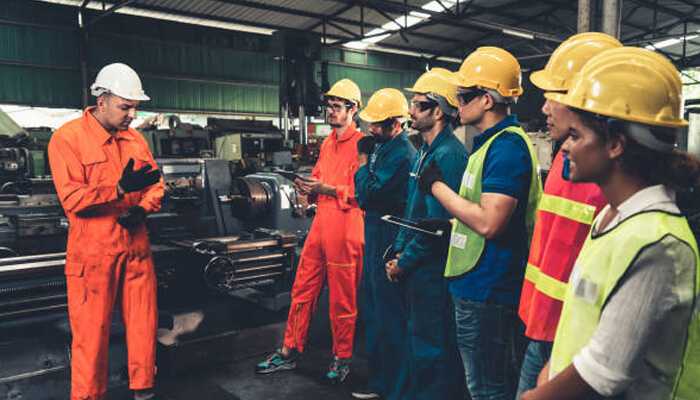If you’re responsible for a busy warehouse, you know that just one serious accident can bring operations to a halt and expose you to serious liability issues and risks. To stay ahead, you need to know the most common safety risks for warehouses that are lurking in your facility (and how to confront them head-on.
Top 5 Biggest Safety Risks for Warehouses
1. Forklift and Material-Handling Accidents
Forklifts and pallet jacks are the workhorses of any warehouse, but they can also be among the most dangerous. When operators speed through aisles or make sharp turns with heavy loads, you risk collisions with shelving, equipment, or even people. And then there’s the risk of poorly-secured pallets that can tip or fall.
You can mitigate these threats by enforcing strict operator training and certification, establishing clear traffic lanes, and requiring pre-shift equipment inspections. But there’s always going to be some level of risk involved.
2. Slip, Trip, and Fall Hazards
You think of warehouse floors as flat and sturdy, but they’re often littered with spilled liquids, stray packing materials, trailing extension cords, etc. Even a small misstep on an uneven or slick surface can lead to major injuries or broken bones.
3. Inventory Storage and Racking Collapses
Your warehouse racks hold thousands of pounds of product – often stacked high to maximize space. But here’s what you’re probably not thinking about: a misloaded beam or a poorly maintained racking system can give way without warning. When that happens, you’re looking at a domino effect of falling goods and injuries.
4. Machinery and Equipment Malfunctions
Automated conveyor belts, packaging machines, and heavy-duty presses keep your fulfillment line humming, but they also require regular maintenance. Lockout-tagout procedures and routine preventive maintenance checks are nonnegotiable. Don’t let downtime pressures tempt you to skip a safety inspection.
5. Fire and Chemical Hazards
Warehouses often store flammable materials that can ignite if exposed to sparks or overheating equipment. A single overloaded electrical circuit or unattended hot work operation can spark a blaze that spreads quickly.
The Power of Third-Party Safety Consulting
You’ve likely already tackled many of warehouse risks internally – tightened procedures, posted reminders, and trained teams. But there’s power in bringing in a third party safety consulting firm to help identify risks and propose solutions. An outside expert can perform a fresh, unbiased audit, uncovering hidden warehouse safety hazards you’ve grown accustomed to. They’ll deliver a concrete action plan, complete with prioritized fixes, realistic timelines, and cost-benefit analysis.
A third party can also guide you through compliance audits and insurance reviews. This reduces your exposure to fines or premium hikes. And by demonstrating a commitment to continuous improvement, you’ll foster a culture where every team member feels empowered to speak up about safety.
How to Leverage Insights for Action
Knowing your top warehouse safety risks isn’t enough. You must turn that insight into measurable safety improvements:
1. Develop a Risk-Based Audit Schedule
Break your warehouse into zones and rank each by traffic, past incidents, or asset value. Then set a cadence – weekly for high-risk areas, monthly for moderate, and quarterly for low-risk spots – to keep hazards from slipping through the cracks. With so much to get done in such little time, this is the only feasible way to do it without bloating your expense sheet.
2. Embed Ongoing Training and Micro-Learning
Instead of one big annual safety class, sprinkle in five-minute shift-start briefings that spotlight a single risk or procedure. These quick refreshers reinforce the big picture without pulling people off the floor for hours. They also tend to be much more practical and useful on a weekly basis.
3. Integrate Real-Time Monitoring Technology
Use simple IoT sensors or digital checklists to flag overloads on racks or overdue maintenance tasks the moment they happen. This way, you solve problems before they grow into costly repairs or accidents.
4. Empower Your Team to Co-Create Solutions
Invite frontline workers to report hazards with a tap of their phone or a note on a shared board – and reward the best ideas. This is how you get the group to buy into what you’re doing. (When your people feel ownership over safety, they’ll spot issues faster and rally around fixes.)
5. Continuously Refresh Your Safety Playbook
After every incident or near miss, spend ten minutes capturing lessons learned and tweak your written procedures accordingly. By revisiting your playbook regularly – say, every quarter – your safety strategy tends to evolve with your operations.
Putting it All Together
It might seem like it during a quarterly board meeting review, but safety isn’t static. Your warehouses safety has real influence on the lives of your employees on a day-in and day-out basis.
With this in mind, revisit your protocols regularly and update your procedures to reflect lessons learned. There’s always room for improvement here!




